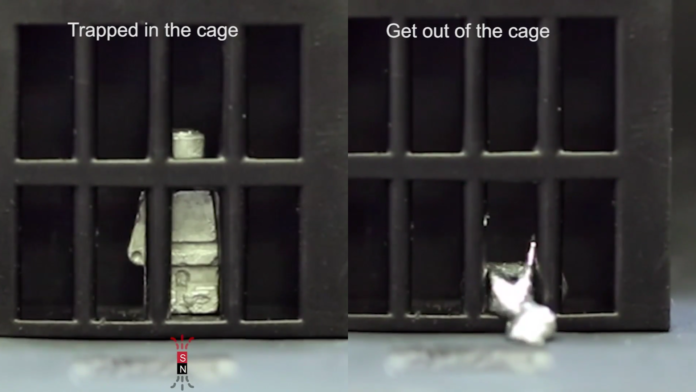Scientists at Chinese, Hong Kong, and American universities have created a metal microbot that can melt, slide through secure cage bars, and then turn back into solid, before resuming tasks.
The team of scientists made the microbot using a composite of metals with a low melting point as part of a study into metal microparticles and presented their findings in the journal Matter(Opens in a new window). The inventors believe the robot, which has been likened to the cyber killer T-1000 in “The Terminator” movie franchise, can be of use in clinical and mechanical settings as it can get to hard-to-reach spaces.
During the study, the microbot turned into liquid form 1 minute and 20 seconds after scientists shot it with magnetic fields at alternating currents, which increased its temperature to 95 Fahrenheit (35 Celsius). Once liquid metal, the microbot was maneuvered through the gaps in a cage using more magnets.
As The Washington Post notes(Opens in a new window), the microbot was able to lengthen, divide, and merge in its liquid form while when solid it was capable of being driven at more than three miles per hour and could carry objects up to 30 times its weight. The robot measures less than 0.4 inches in width when solid.
Speaking to the Post, Chengfeng Pan, the study’s co-author and engineer at the Chinese University of Hong Kong said the material of the microbot could achieve “fast movement and heavy load-bearing” when in its solid state and “shape changing in its liquid state.”
“Potentially, this material system can be used for applications in flexible electronics, health care, and robotics,” he added.
According to the scientists who worked on the study, the news marks the first time that a material that permits both shifting shape and the carrying of heavy loads has been found for use in microbots.
In a different experiment, scientists deployed the microbot inside a model human stomach in order to remove an unwanted object. When solid it was steered through the model organ before it was melted by remotely controlled magnetic fields when the object had been located. In its liquid state, the microbot reportedly stretched around and hugged the object before it was cooled into solid form and driven out of the model organ.
Recommended by Our Editors
The scientists said in their report that the experiment demonstrated the robot could remove foreign objects or deliver drugs in a model stomach.
Brad Nelson, a robotics professor at ETH Zurich who did not participate in the study told the Post that while developments in microbot technology such as this one are exciting and potentially applicable to clinical settings, this particular microbot’s use of a toxic metal compound (neodymium iron boron) means it would have to be completely removed from the body after use.
Nelson said: “The folks that are really looking at clinical applications of these devices, we want to look at materials that can degrade in the body, remain in the body, without causing harm to the patient.”
Get Our Best Stories!
Sign up for What’s New Now to get our top stories delivered to your inbox every morning.
This newsletter may contain advertising, deals, or affiliate links. Subscribing to a newsletter indicates your consent to our Terms of Use and Privacy Policy. You may unsubscribe from the newsletters at any time.
Hits: 0
















